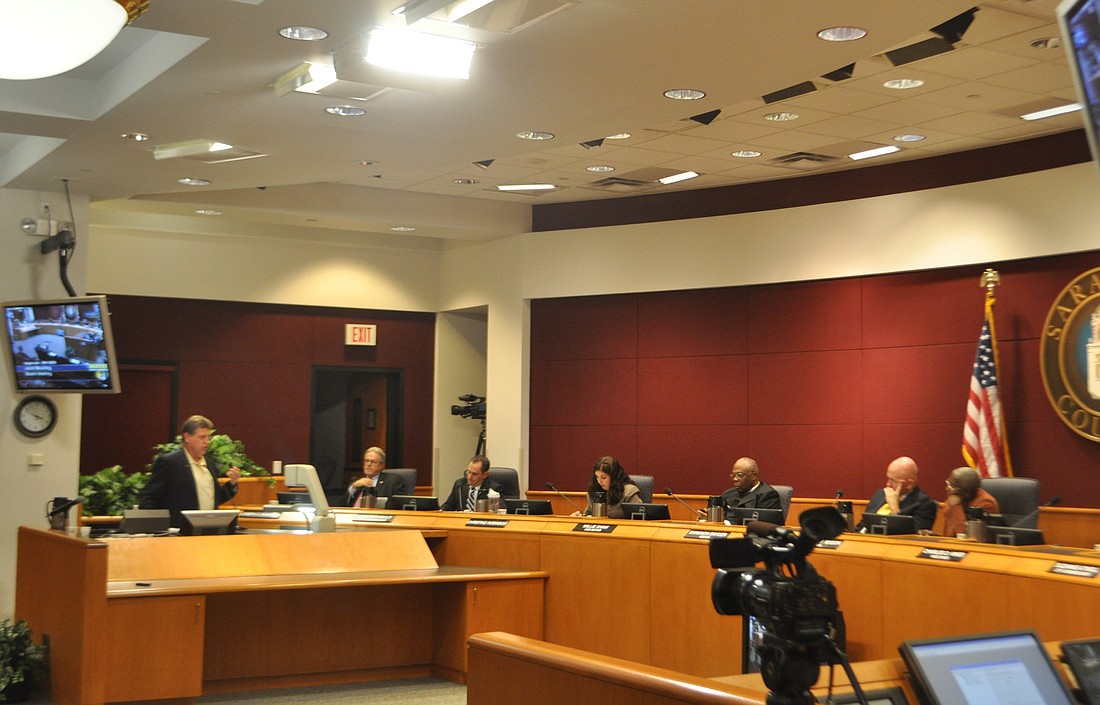- April 16, 2024
-
-
Loading

Loading

Ever since the city of Sarasota and Sarasota County hired Robert Marbut in August to address regional homelessness issues, one of the most hotly contested topics of discussion has been the location of a homeless shelter.
The rhetoric among city commissioners has been strong at times, with two commissioners voicing opposition to a countywide shelter within the city. Based on comments at Monday’s public hearing on Marbut’s initial report and input from other stakeholders affected by homelessness, many Sarasota residents are taking a more nuanced stance as the city and county seek to act on Marbut’s advice.
At Monday’s joint meeting of the city and county commissions, three sites were identified as potential locations for a regional “come as you are” shelter for homeless adults. The proposed sites — located at 1330 N. Osprey Ave., 1800 East Ave. and 1121 Lewis Ave. — are all in the city’s District 1, between 10th Street and Dr. Martin Luther King Way.
The preferred location outlined in Marbut’s report was the city-owned site on Osprey Avenue, which could also expand to include a UPS-owned property at 1530 N. Osprey Ave. The city and county directed staff to also get preliminary environmental reports on the other properties, so the sites can be evaluated again at a later date.
Vice Mayor Willie Shaw, who represents District 1, has been outspoken about his opposition to a shelter in North Sarasota, an area he feels has been unduly burdened with less-desirable projects. City Commissioner Susan Chapman, another opponent of a shelter in the city, voted with Shaw at Monday’s meeting to postpone any action until a public meeting of District 1 residents could be held to discuss the report.
That motion failed, 2-3, as other commissioners voted to vet the three sites under consideration.
One speaker at Monday’s meeting shared the concerns of Shaw and Chapman. Barbara Langston, president of the Amaryllis Park Neighborhood Association, said it was not only unfair to pin a shelter on North Sarasota, but that a city-located shelter would be poorly suited to fit the needs of the region’s homeless. Amaryllis Park is located just to the north of the proposed shelter locations.
The other eight speakers, in varying degrees, encouraged the city and the county to continue to move forward in implementing the changes outlined in Marbut’s report, such as the shelter.
That included people like Virginia Hoffman, whose art studio is located in District 1. Hoffman said she supported Marbut’s plan and would welcome a shelter even closer to her property — although she said the concerns of some North Sarasota residents were valid and should be addressed, to some degree.
It also included Chris Gallagher, an architect and the chairman-elect of the Greater Sarasota Chamber of Commerce. Gallagher lives in District 1, north of Fruitville on Orange Avenue, and said acting on Marbut’s report was essential for combating the homelessness issues that he and his wife regularly encounter.
Although it would be nice to have a shelter in a more remote area of the county, Gallagher said, it would ultimately be a less-effective way of mitigating the current situation.
"Putting this somewhere where it's not going to work doesn't make any sense," Gallagher said. "It gets it away from my own home and it gets it away from District 1, but the real goal here is: Is it really going to work?"
The members of the Sarasota Downtown Merchants Association aren’t immediately adjacent to the proposed shelter locations, but homelessness issues have been a primary concern for many of those businesses. Ron Soto, owner of Soto Optical and president of the merchant group, said a large shelter located near the urban core would be less than ideal for downtown businesses.
“I think it should be a county type of thing, to serve the whole county,” Soto said. “I myself would prefer not having everything right there on 12th Street; it needs to be spread someplace else.”
Still, Soto said, he would prefer a city-located shelter to no shelter at all. Regardless of what action the city and county took, he wanted to see progress made in combating homelessness.
“I hope everything works out,” Soto said. “Downtown is depending on it.”
Gillespie Park sits just to the south of the Osprey Avenue site. Linda Holland, president of the Gillespie Park Neighborhood Association, said the group has expressed its concerns about how a nearby shelter might affect residents. Still, she said, the group had varying opinions on what action they felt the city should take.
“There are no simple solutions and no simple answers,” Holland said. “You could probably talk to lots of people with lots of ideas and passions about how they feel about the situation.”
Like Soto and several speakers at Monday’s meeting, Holland emphasized the importance of capitalizing on the momentum at hand to take a significant step toward addressing homelessness in the region.
“We just can't spend our time — which the city tends to do — squabbling about things, trying to find things that satisfy every single person, that are perfect,” Holland said. “I think the timing is right to move forward, and I hope that's what we can all do together.”
Contact David Conway at [email protected]